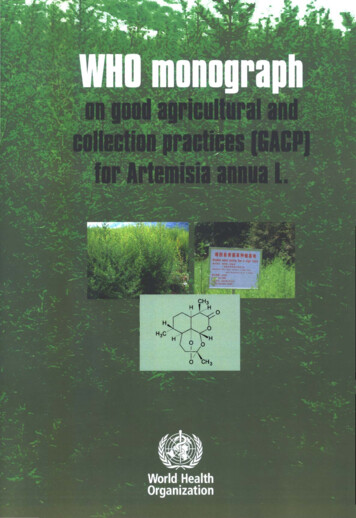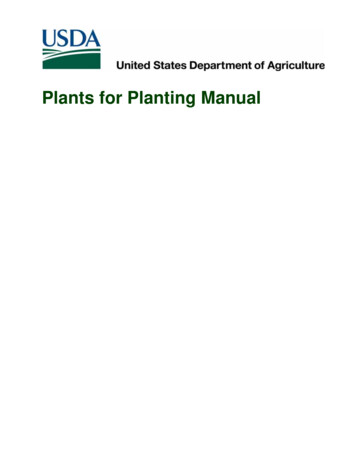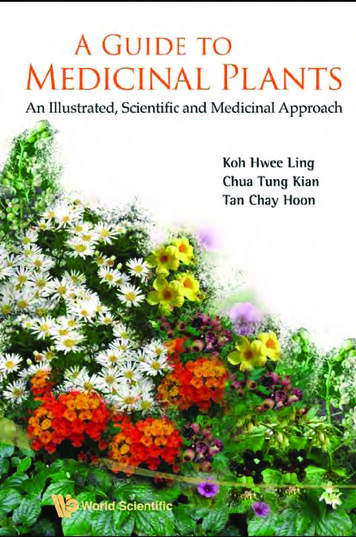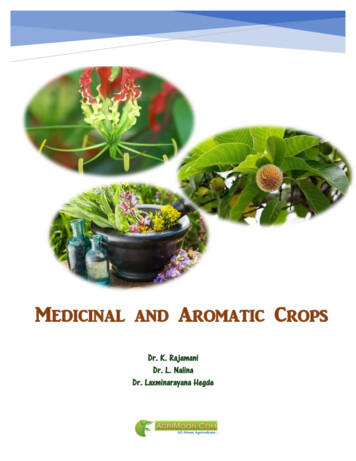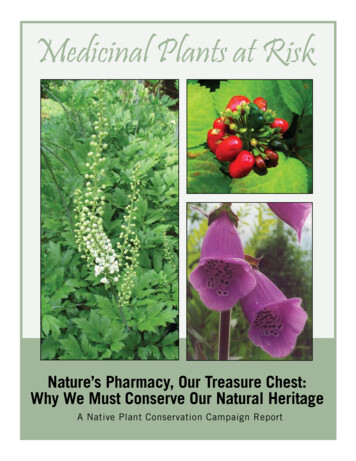
Transcription
Medicinal Plants at RiskNature’s Pharmacy, Our Treasure Chest:Why We Must Conserve Our Natural HeritageA Native Plant Conservation Campaign Report
By Emily Roberson,Native Plant Conservation Campaign DirectorMarch 2008Layout & Design:Anna Mirocha & Julie MillerFront Cover:Black cohosh in flower and ginseng berries photos byJeff McCormack/gardenmedicinals.comFoxglove flowers courtesy horizonherbs.comSpecial thanks to those who provided funding, input, peer review, and otherassistance during the development of this report.The Native Plant Conservation Campaign is a project of the Center for BiologicalDiversity. The Center works through science, law, and creative media to secure afuture for all species, great or small, hovering on the brink of extinction.Center for Biological DiversityP.O. Box 710Tucson, AZ 85702520.623.5252www.biologicaldiversity.org
Table of ContentsExecutive Summary.1Introduction.3Threats: Habitat Destruction, Bioprospecting, and Overharvesting.5Examples of Naturally Derived Medicines. . . . . . . . . . . . . . . . . . . . . . . . . . . . . . . 9Conclusion And Recommendations. . . . . . . . . . . . . . . . . . . . . . . . . . . . . 1 3References.15GoldensealPhoto courtesy Kathryn A. Lynch and Eric T. Jones
MEDICINAL PLANTS AT RISKExecutive Summary“The land abounds in these natural remedies and to classify the plants, give their names and describe theirproperties, the presence of a botanist would be required. It is certain that many illnesses are cured by people and theyhave their remedies for everything, many quite effective. For this reason not a few prefer their herbs and roots to ourunguents and salves.”— Reply by a missionary at Mission San Antonio as to what knowledge the natives had of medicines(Geiger and Meighan, 1976)Medicinal plants grow naturally around us. Over centuries, cultures around the worldhave learned how to use plants to fight illness and maintain health. These readilyavailable and culturally important traditional medicines form the basis of an accessible andaffordable health-care regime and are an important source of livelihood for indigenous andrural populations.Increasingly, medicinal species that reside in natural areas have received scientific andcommercial attention. In the United States, of the top 150 prescription drugs, at least 118 arebased on natural sources. A child suffering from leukemia in 1960 faced a 10 percent chanceof remission; by 1997, the likelihood of remission had been increased to 95 percent thanks totwo drugs derived from a wild plant native to Madagascar.But we still know little about the treasure trove inhabiting our wild places. As of 1995, lessthan 1 percent of all tropical plant species had been screened for potential pharmaceuticalapplications.As medicinal plants receive increased scientific and commercial attention, there isincreasing pressure on the wild plant populations from which most medicinal plantsare harvested. Overharvesting has placed many medicinal species at risk of extinction.Commercial exploitation has also sometimes led to traditional medicines becomingunavailable to the indigenous peoples that have relied on them for centuries or millennia.For all of these reasons, the study and conservation of medicinal plant (and animal) specieshas become increasingly urgent. The accelerating loss of species and habitat worldwideadds to this urgency. Already, about 15,000 medicinal plant species may be threatened withextinction worldwide. Experts estimate that the Earth is losing at least one potential majordrug every two years.Page 1
NATURE’S PHARMACY, OUR TREASURE CHESTOrganizations and governments throughout the world are rising to meet this challenge.Through the Global Convention on Biological Diversity, the Convention on InternationalTrade in Endangered Species, and non-governmental organizations such as those workingto develop an International Standard for Sustainable Wild Collection of Medicinal andAromatic Plants (ISSC-MAP), scientists and policymakers are proposing new proceduresand policies to safeguard our remaining medicinal treasures in the wild so that they canprotect this and future generations.Goldenseal in flowerPhoto by Jeff McCormack/gardenmedicinals.comCenter for Biological DiversityPage 2
MEDICINAL PLANTS AT RISKIntroductionThis planet’s spectacular web of life suppliescountless gifts to humanity. Healthy wildecosystems clean the water we drink andproduce the air we breathe, the foods we eat,the medicines that cure and protect us, and thematerials that form our shelter and clothing.Wild ecosystems moderate our climate andmitigate natural hazards such as hurricanes,floods, and landslides. They even protect usfrom pests and diseases — for example, speciessuch as spiders literally filter insects from the air,just as plant roots filter disease organisms andpollutants from streams and other water sources.Individuals, communities, and economiesdepend on intact diverse native wildlands for allof these irreplaceable services.The medicinal species that reside in naturalareas have received increasing scientificand commercial attention in recent years.Worldwide, between 50,000 and 80,000 floweringplants are used medicinally (IUCN SpeciesSurvival Commission, 2007; Marinelli, 2005).In the United States, of the top 150 prescriptiondrugs, at least 118 are based on natural sources:74 percent come from plants, 18 percent fromfungi, 5 percent from bacteria, and 3 percentfrom vertebrate species such as snakes or frogs(Ecology Society of America, 1997).The life-saving benefits of this treasure trove areenormous: According to the National Cancer Institute,at least 70 percent of new drugs introduced inthe United States in the last 25 years are derivedfrom natural sources (Steenhuysen, 2007). Plant-derived anti-cancer drugs such as taxol,first isolated from the Pacific yew, save at least30,000 lives per year in the United States (Daily,1997). Thanks to two drugs derived from alkaloidsof Madagascar’s rosy periwinkle, the likelihoodof remission for a child suffering from leukemiaincreased by 85 percent between 1960 and 1997(Daily, 1997; Botanic Gardens ConservationInternational, 1996). New compounds, such as one recentlydiscovered in a plant in Madagascar, are likelyto provide novel antibiotics and help curb theepidemic of antibiotic-resistant diseases (Wanget al., 2006). New classes of anti-viral drugs derived fromplants such as star anise provide unprecedentedhope for combating potential epidemic viraldiseases such as flu (Laurance, 2005).Black cohoshPhoto courtesy horizonherbs.comPage 3 Drugs to fight life-threatening diseases suchas diabetes, HIV, and diarrhea — and evensubstances to protect crops from slugs — arebeing developed from plants, microorganisms,amoebae, and other species from Africancountries such as Egypt, Somalia, Libya, andGambia (Barnett, 2006).
NATURE’S PHARMACY, OUR TREASURE CHESTOf course, the use of wild species to cureand resist disease is nothing new. In China,medicinal plant use goes back at least 4,000years, and healers have used more than 5,000plant species (Tuxhill, 1999). More than 80percent of South Asia’s 1.4 billion peoplehave no access to modern health care; theyrely instead on traditional medicine usingnative species. In fact, many indigenous andlocal communities are immense reservoirsof traditional knowledge that can benefitbiotechnology, agriculture, pharmaceuticaldevelopment, and health care.Our ability to use wild resources to preventdisease and improve health is not dependenton humans alone. The stability of our suppliesof food, fiber, and other crops is threatenedby pests, diseases, climate change, and otherever-changing stresses. According to theEcology Society of America (1997), society’sability to maintain crop production dependson compounds and genes derived from wildrelatives of animal and plant crop species. Theextraction of genetic resources from the world’sso-called “library in the wild” has recentlyaccounted for annual increases of at least 1percent in agricultural productivity, equivalentto about 1 billion in revenues (Ecology Societyof America, 1997.Bloodroot flowering near Ithaca, New YorkPhoto courtesy Kathryn A. Lynch and Eric T. JonesAlthough this report focuses on medicinalplant species, it is worth noting that the abovereferenced estimate is confined to medicinesand so excludes losses of new foods, fibers,and other potential tools that may fight famine,create housing, or generate other benefits tolocal communities, societies, and economies.Our ignorance becomes increasingly dangerousas the rates of loss of plants, fish, wildlife,and habitat accelerate (Marinelli, 2005). Eachspecies lost to extinction represents not only thepotential loss of life-saving cures for diseasessuch as cancer or AIDS, but also the loss ofpossible protein- or vitamin-rich foods or moreproductive and stable crops.Plant-derived anti-cancer drugssave at least 30,000 lives per yearin the United States alone.Center for Biological DiversityPage 4
MEDICINAL PLANTS AT RISKThreats: Habitat Destruction, Bioprospecting, andOverharvestingMedicinal plants are at increasing riskfrom destruction of their habitats,bioprospecting for new sources, andoverharvesting of known medicinal species.Currently, the conservation group UnitedPlant Savers lists 19 North American medicinalnative plants as “at risk.”An additional 22 plantspecies are identified onthe group’s “to watch” list(www.unitedplantsavers.org/UpS At Risk List.html). The GlobalConvention on BiologicalDiversity, the Conventionon InternationalTrade in EndangeredSpecies (CITES), theForest Service, theNational Center for thePreservation of MedicinalHerbs (NCPMH),other herb societies,and scientists alsotrack, maintain lists of,and work to conserveimperiled medicinalspecies worldwide.Bioprospecting and “Biopiracy”Medicinal species are very profitable. A1995 analysis estimated that each new plantderived drug is worth an average of 94million to drug companies and 449 millionto society (Mendelsohnand Bialick, 1995 citedin Daily, 1997). Otherestimates have reportedsales ranging from 1.5to 5.7 billion annuallyfor non-prescriptionmedicinal plants inthe United States,and 24.4 billion insales worldwide. Thereported market valueof prescription and overthe-counter plant-baseddrugs in 1985 was 19.8billion in the UnitedStates, and 84.3 billionworldwide (Pearce andMoran, 1994; Tuxhill,1999).This profitability canmake traditionallyused, accessible, andHabitatFoxglove flowersaffordable medicinalDestructionPhoto courtesy horizonherbs.complant resources lessavailable to populationsAs of 1995, less than 1 percent of all tropicalthat have relied on them for centuries. Theplant species had been screened for potentialterm “biopiracy” has been coined to describepharmaceutical applications (World Atlasthe practice of private companies patentingof Biodiversity, 1995). Habitats are beingtraditional remedies from the wild and sellingdestroyed more quickly than scientists canthem at a vast profit, often allowing little orinvestigate them. At current extinction rates,none of that profit to go back to the country orexperts estimate that the Earth is losing atindigenous and local communities of originleast one potential major drug every two years(Barnett, 2006). Sometimes indigenous and(World Atlas of Biodiversity, 1995).local communities who have used a remedyfor centuries may be prevented from usingPage 5
NATURE’S PHARMACY, OUR TREASURE CHESTor benefiting from it after patenting. Forexample, the neem tree, a South Asian relativeof mahogany, has yielded extremely effectiveand profitable germicides, fungicides, andother compounds. By 1995, at least 50 patentshad been granted to U.S. and internationalcorporations for products extracted from thisspecies. These patents have been contested byenvironmentalists and international aid groups(Torrance, 2000).In 2001, following an Indian proposalin response to the patents of traditionalproducts such as neem and tumeric (usedfor wound healing), the World IntellectualWorldwide, between 50,000 and80,000 flowering plants are usedmedicinally. Of these, at least15,000 may face extinction due tooverharvesting and habitat loss.Property Organization (WIPO) established aTraditional Knowledge Task Force consisting ofrepresentatives from the United States, Japan,the European Union, China, and India. TheTask Force carried out an extensive search oninternational patent databases and found morethan 5,000 patent references on 90 medicinalplants in U.S. Patent and Trademark Officedatabases alone. Out of these 90 medicinalplants, 80 percent of patents were generatedfor seven plants of Indian origin. An extensiveexamination of 762 patents granted onmedicinal plants by the Patent and TrademarkOffice revealed that more than 45 percent ofpatents could be categorized as belonging totraditional knowledge systems (CSIR News,2001).Center for Biological DiversityBecause of the controversy surrounding therights of nations and indigenous communitiesto traditional medicines and local nativespecies and products, the Global Conventionon Biological Diversity specifically recognizesthe property rights of indigenous and localcommunities over commercial exploitation oftraditional remedies and other native species(Barnett, 2006; see also Convention text: fault.shtml).OverharvestingIn addition to the loss of access to traditionalremedies by indigenous peoples, overcollectionof species poses a significant threat to somecommercially valuable wild species and totheir habitats as well. This threat has beenknown for decades. According to the WorldConservation Union (IUCN), about 15,000medicinal plant species may be threatened withextinction worldwide from overharvesting(see ISSC-MAP, 2007; IUCN Species SurvivalCommission, 2007). More than 30 years ago, theWorld Wildlife Fund and the IUCN formed TheWildlife Trade Monitoring Network (TRAFFIC)to monitor and control global trade in wildspecies, including those used for medicinalpurposes. TRAFFIC and the U.S. NationalPark Service have published several reportsdocumenting overcollection threats to wildspecies on U.S. public lands (Robbins, 1999).Page 6
MEDICINAL PLANTS AT RISKExamples of Species at RiskExamples of species that have been identifiedas imperiled in the wild include: Slippery elm (Ulmus rubra): The gummylining of the bark of the slippery elm haslong been used in North America, especiallyAppalachia, as a soothing agent for coughs,gastrointestinal ailments, and skin irritations.But now, slippery elm and other herbalproducts that were once used seasonally bylocals are in demand by millions. Slipperyelm wood has no commercial value, so treesare stripped of bark and then left to die.Approximately 12 trees are sacrificed for each50 pounds of dried bark. Fifty-pound bagsof bark can command as much as 150. Thisspecies has been identified at “at risk” by theU.S. Forest Service, the U.S. Park Service, andthe National Center for the Preservation ofMedicinal Herbs (NCPMH) (Associated Press,2006).Who knows, or can say, whatpotential cures for cancer orother scourges, present orfuture, may lie locked up in thestructures of plants which mayyet be undiscovered, much lessanalyzed? Sheer self-interestimpels us to be cautious.— From U.S. Congressionaldeliberations on the bill introducingthe Endangered Species Act, 1973Page 7Ginseng rootsPhoto courtesy Kathryn A. Lynch and Eric T. Jones American ginseng (Panax quinquefolius):Sales of wild and cultivated ginseng exceed 25 million each year in North America, withwild ginseng seen as the more desirable type.Wild ginseng is so much more profitable thancultivated ginseng that there is great concernabout the decline and imperilment of thespecies in the wild (U.S. Forest Service, 2001).This species is regulated under CITES. Yew (Taxus species): Yew trees, includingthe Pacific yew (Taxus brevifolia) and Chineseyew (Taxus chinensis), are used to produce thepopular, profitable, and effective cancer drugtaxol. CITES has identified several yew speciesas in need of protection from overharvesting forinternational trade.
NATURE’S PHARMACY, OUR TREASURE CHESTAt current extinction rates, expertsestimate that the Earth is losingat least one potential major drugevery two years. Black cohosh (Cimicifuga racemosa):This member of the buttercup family hastraditionally been used to treat a variety ofconditions including colds, pain, rheumatism,and menopause. Nearly 100 percent of blackcohosh supply comes from wild harvesting.The species has been identified by the U.S.Forest Service and other institutions as at riskfrom overharvesting and habitat degradation(U.S. Forest Service, 2001). Goldenseal (Hydrastis canadensis): Thisbuttercup-family member has numeroustraditional uses as a tonic and to treatailments such as hemorrhoids. According tothe NCPMH, more than 60 million goldensealplants are being harvested annually withoutbeing replaced, and goldenseal is alreadyconsidered rare, threatened, or endangeredin many states and by CITES (see NCPMHWeb site; U.S. Forest Service, 2001).International trade in this and many otherspecies is regulated under CITES to preventoverharvesting from the wild (see www.cites.org).Black cohosh in flowerPhoto by Jeff McCormack/gardenmedicinals.comCenter for Biological DiversityPage 8
MEDICINAL PLANTS AT RISKExamples of Naturally Derived MedicinesThe following tables show a small portion of the species used to make popular — and profitable— naturally derived medicines. Some examples of non-plant medicinal species are included.Plant-derived MedicinesDRUGMEDICINAL USE*SOURCE **PLACE OF ORIGINAloeTreatment of burnsand woundsAloe species (Marinelli,2005)South Africa,Arabian PeninsulaAspirinPain relief, promotionof heart- health, bloodthinningWillow (Salix species)(Tuxhill, 1999)EuropeBlack cohoshTreatment of hormonal Black cohosh (Cimicifuga Eastern Uniteddisorders, rheumatism racemosa) (Marinelli,States and Canada2005)BloodrootTreatment of skindisorders and cancerBloodroot (SanguinariaCanadensis) (Robbins,1999)Southeastern UnitedStatesCamphorRheumatic pain reliefCamphor tree(Cinnamomum camphora)(Tuxhill, 1999)AsiaCodeinePain relief, coughsuppressionOpium poppy (Papaversomniferum) (OnlineMedical Dictionary,2007)SoutheasternEurope, westernAsiaColchicineCancer and gouttreatmentAutumn crocus(Colchicum autumnale)(Tuxhill, 1999)EurasiaDevil’s club shrubInfection cure, diabetes Oplopanax speciesWestern Northand tuberculosis(Marinelli, 2005; MPWG, Americatreatment2007)DigitalisHeart failure treatment European foxglove(Digitalis purpurea)(Tuxhill, 1999)Page 9Europe
NATURE’S PHARMACY, OUR TREASURE CHESTDRUGMEDICINAL USE*SOURCE PLANT**PLACE OF ORIGINGamma-linolenic acidEczema, cancer,and nerve-damagetreatmentEvening primrose(Oenothera biennis)(Online MedicalDictionary, 2007)North AmericaHoodiaWeight lossHoodia plant (HoodiaSouth Africagordonii) (Online MedicalDictionary, 2007)IrinotecanColon cancer treatment Xi shu tree (Camptothecaacuminata) (OnlineMedical Dictionary,2007)ChinaMadagascarperiwinkleTreatment of leukemia, Madagascar periwinkleHodgkin’s disease, and (Catharanthus roseus)other cancers(Daily, ilation, nasal Ma huang shrubdecongestion, allergies (Ephedra sinica) andother plants and fungi;(Tuxhill, 1999)ChinaPilocarpineGlaucoma treatmentJaborandi plant(Pilocarpus species)(Online MedicalDictionary, 2007)Amazon BasinQuinine, quinidineMalaria and heartdisease treatmentCinchona species(Tuxhill, 1999) (OnlineMedical Dictionary,2007)South AmericaScopolamineSedation, motionsickness reductionDatura and SolananceaespeciesAmericasShikimic acid (e.g.,Tamiflu)Cure of viral diseases(influenza)Star anise (Illiciumverum) (Laurance, 2005)Asia* Neither the Native Plant Conservation Campaign nor the Center for Biological Diversity hasverified the effectiveness of these products.** Forms of some substances derived from these species are also poisonous.Center for Biological DiversityPage 10
MEDICINAL PLANTS AT RISKPlant-derived Medicines, ContinuedDRUGMEDICINAL USE*SOURCE PLANT**PLACE OF ORIGINSlippery elm barkliningRelief of coughs,gastrointestinalailments, skinirritationsSlippery elm (UlmusSoutheastern Unitedrubra) (Associated Press, States8/9/06)TaxolTreatment of breastand other cancersTaxus species (Medicinal North America,Plant Working Group,Asia2007)TazopsineMalaria treatment (indevelopment)Strychnopsis thouarsiiMadagascarbark (Carraz et al., 2006)TopotecanOvarian and lungcancer treatmentXi shu tree (Camptotheca Chinaacuminata) (Steenhuysen,2007)TubocuranineSurgical musclerelaxationCurare vine(Chondrodendrontomentosum) (OnlineMedical Dictionary,2007)South AmericaBloodroot flowerPhoto Daniel Reed/2binthewild.comPage 11
NATURE’S PHARMACY, OUR TREASURE CHESTMedicines Derived From Other SpeciesDRUGMEDICINAL USE*SOURCE **PLACE OF ORIGINByettaDiabetes treatmentGila monster (Helodermasuspectum) saliva(McClain, 2005)SouthwesternUnited StatesPenicillinBacterial infection cure Penicillium fungusspecies(Abramovitz,1997)WidespreadAloe veraPhoto by Anna Mirocha* Neither the Native Plant Conservation Campaign nor the Center for Biological Diversity hasverified the effectiveness of these products.** Forms of some substances derived from these species are also poisonous.Center for Biological DiversityPage 12
MEDICINAL PLANTS AT RISKConclusion and RecommendationsHabitat loss and unchecked commercialization of wild medicinal plants is threatening thefuture of vital resources, as well as the beauty, diversity, and natural heritage of our planet.As wildlands are destroyed or degraded, we lose unique and precious species, from flowers tofrogs to butterflies, and with them potential resources to combat hunger, poverty, natural disasters,and social and economic insecurity. This loss of diversity may also take with it important curesfor diseases — both those we face now and those that may emerge in the future. Uncheckedcommercialization may render important traditionally used medicinal plant resources inaccessibleand unaffordable to populations that have relied on them for centuries — as well as to the rest ofthe world.When President Nixon and Congress enacted the Endangered Species Act in 1973, they recognizedthat species conservation and human survival go hand in hand. Congress’ deliberations leading upto the passage of the law emphasized this point. The House Committee on Merchant Marine andFisheries, in explaining the need for H.R. 37 — a bill that contained the essential features of thesubsequently enacted Endangered Species Act — stated:As we homogenize the habitats in which these plants and animals evolved, and as weincrease the pressure for products that they are in a position to supply (usually unwillingly),we threaten their — and our own — genetic heritage. The value of this genetic heritage is,quite literally, incalculable.From the most narrow possible point of view, it is in the best interests of mankind tominimize the losses of genetic variations. The reason is simple: they are potential resources.They are keys to puzzles which we cannot solve, and may provide answers to questionswhich we have not yet learned to ask.To take a homely, but apt, example: one of the critical chemicals in the regulation ofovulations in humans was found in a common plant. Once discovered, and analyzed,humans could duplicate it synthetically, but had it never existed — or had it been driven outof existence before we knew its potentialities — we would never have tried to synthesize it inthe first place.Who knows, or can say, what potential cures for cancer or other scourges, present or future,may lie locked up in the structures of plants which may yet be undiscovered, much lessanalyzed? Sheer self-interest impels us to be cautious.— Report of the House Committee on Merchant Marine Fisheries, July 27, 1973Page 13
NATURE’S PHARMACY, OUR TREASURE CHESTOur responsibilities are clear:We must re-commit ourselves to conservationof our remaining wild species and wild placesso that the loss of these resources is minimized.The Global Convention on Biological DiversityArticle 8 (j) on Traditional Knowledge,Innovations and Practices proposescurbing overexploitation and destructivebioprospecting by developing procedures:For those species that are in commercial use, wemust adopt and implement sustainable-use andcultivation measures. Such methods are alreadybeing developed through the Convention onBiological Diversity, CITES, the National Centerfor the Preservation of Medicinal Herbs, ISSCMAP, the Medicinal Plant Working Group, andother initiatives and organizations (see “WebSites”). to ensure that indigenous and localcommunities obtain a fair and equitableshare of the benefits arising from the use andapplication of their traditional knowledge;The ISSC-MAP, for example, proposes a seriesof actions including: to regulate how impact assessmentsare carried out regarding any proposeddevelopment on sacred sites or on land andwaters occupied or used by indigenous andlocal communities; and the mapping of wild populations ofcommercial species; the conservation and restoration of theirhabitat; compliance with all applicable lawsand regulations such as state and federalEndangered Species Acts, public land usepolicies, harvesting prohibitions, permittingrequirements, and quantity limitations; working with local and indigenouscommunities to learn and respect their rights,traditions, and practices; the development and implementation ofresponsible and sustainable managementpractices; and the development and implementation ofresponsible business practices.Center for Biological Diversity to ensure that private and public institutionsinterested in using such knowledge obtain theprior informed approval of indigenous andlocal communities; to assist governments in the developmentof legislation or other mechanisms to ensurethat traditional knowledge and its widerapplications are respected, preserved, andmaintained.The recognition of the value of medicinalspecies and of our remaining biologicaldiversity in general must be incorporated intoour laws, as well as our land and resourcemanagement methods, through adoption ofthese types of priorities, management practices,and philosophical frameworks. Unless we actnow, we are doomed to lose countless lifesaving treasures, often without even knowingof their existence. No intelligent speciesshould needlessly risk its future throughthoughtlessness and waste.Page 14
MEDICINAL PLANTS AT RISKReferencesAssociated Press. 2006. “Slippery Elm TreesFall Victim to Poachers.” August 9, 2006.Abramovitz, J.N. 1997. “Valuing Nature’sServices.” In: State Of The World 1997: AWorldwatch Institute Report On Progress Towarda Sustainable Society. New York: W.W. Nortonand Co.Balick, M.J., and R. Mendelsohn. 1992.“Assessing the Economic Value of TraditionalMedicines from Tropical Rain Forests.”Conservation Biology 6(1): 128-130.Geiger, M., and C. W. Meighan. 1976. Asthe Padres Saw Them: California Indian Lifeand Customs as Reported by the FranciscanMissionaries 1813-1815. Santa Barbara, CA:Santa Barbara Mission Archive Library.Groombridge, B., and M. D. Jenkins. 2002.World Atlas of Biodiversity: Earth’s LivingResources in the 21st Century. Berkely, CA:University of California Press.Barnett, A. 2006. “The New Piracy in Africa.”Guardian Weekly (UK). September 28, 2006.IUCN Species Survival Commission MedicinalPlant Specialist Group. 2007. “Why Conserveand Manage Medicinal Plants?” Web .html.Botanic Gardens Conservation International,1996. “CITES and Medicinal Plants Study: ASummary of Findings.” Web resource: www.bgci.org/wellbeing/CITES and Med PlantsSummary/.Laurance, J. 2005. “Why an Exotic Fruit is theWorld’s Only Weapon Against Bird Flu.” TheIndependent (UK). Web resource: news.independent.co.uk/uk/health medical/article319716.ece.Carraz, M., et al. 2006. “A Plant-DerivedMorphinan as a Novel Lead Compound ActiveAgainst Malaria Liver Stages.” PLoS Med 3:e513.Marinelli, J. (ed). 2005. Plant: The Ultimate VisualReference to Plants and Flowers of the World. NewYork: DK Publishing, Inc.Centre for Cancer Education. 2007. OnlineMedical Dictionary. University of Newcastleupon Tyne, UK.Council of Scientific & Industrial Research(CSIR). 2001. CSR News 51 (5&6: 1-3).Daily, G. (ed). 1997. Nature’s Services: SocietalDependence on Natural Ecosystems. Covelo, CA:Island Press. 392 pp.Ecological Society of America. 1997.“Ecosystem Services: Benefits Supplied toHuman Societies by Natural Ecosystems.”Issues in Ecology 2. Washington, DC: EcologicalSociety of America.Page 15McClain, C. 1995. “Drug Made from SalivaControls Blood-sugar Level.”Mendelsohn R., and M.J. Balick. 1995. TheValue of Undiscovered Pharmaceuticals in TropicalForests. Economic Botany 49: 223-8.Myers, N. 1983. A Wealth of Wild Species.Boulder, Colorado: Westview.---------. 1979. The Sinking Ark. Elmsford, NY:Pergamon Press.Pearce, D. and Moran, D. 1994. The EconomicValue of Biodiversity. London: IUCN EarthscanPublications, Ltd.
NATURE’S PHARMACY, OUR TREASURE CHESTWeb SitesRobbins, C. 1999. “Medicine from U.S.Wildlands: An Assessment of Native PlantSpecies Harvested in the United States forMedicinal Use and Trade and Evaluation of theConservation and Management Implications.”TRAFFIC North America, The NatureConservancy. Web resource: nhuysen, J. 2007. “Mother Nature Still ARich Source Of New Drugs.” Reuters Limited.
for non-prescription medicinal plants in the United States, and 24.4 billion in sales worldwide. The reported market value of prescription and over-the-counter plant-based drugs in 1985 was 19.8 billion in the United States, and 84.3 billion worldwide (Pearce and Moran, 1994;
